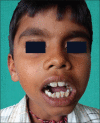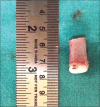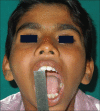Remodeling of Neocondyle
- PMID: 31909041
- PMCID: PMC6933990
- DOI: 10.4103/ams.ams_70_19
Remodeling of Neocondyle
Abstract
Temporomandibular joint (TMJ) ankylosis in children is one of the most complex and challenging problems managed by oral and maxillofacial surgeons. TMJ ankylosis in growing children often leads to facial deformity, difficulty in chewing and swallowing, severe malocclusion, poor oral hygiene, multiple decayed teeth, and impairment of speech. A good functional and esthetic outcome can be achieved after reconstruction with the autogenous grafts. Here, we present a case of a 9-year-old patient treated with condylectomy and ipsilateral coronoidectomy, followed by reconstruction with costochondral graft with 5 years of follow-up. During this period, the reconstructed graft remodeled into a neocondyle and also regrowth of the coronoid process. The mouth opening and facial symmetry were acceptable.
Keywords: Costochondral graft; neocondyle; temporomandibular joint ankylosis.
Copyright: © 2019 Annals of Maxillofacial Surgery.
Conflict of interest statement
There are no conflicts of interest.
Figures








References
-
- Mabongo M. Temporomandibular joint ankylosis in children. J Dent Med Sci. 2013;12:35–41.
-
- Bhat C, Patil S, Kale N, Salunkhe N. Temporomandibular joint fibrous ankylosis – A case report. J Appl Dent Med Sci. 2016;2:112–5.
-
- Kaban LB, Bouchard C, Troulis MJ. A protocol for management of temporomandibular joint ankylosis in children. J Oral Maxillofac Surg. 2009;67:1966–78. - PubMed
-
- Ko EW, Huang CS, Chen YR. Temporomandibular joint reconstruction in children using costochondral grafts. J Oral Maxillofac Surg. 1999;57:789–98. - PubMed

